
The Wild Intelligence of Trees (and What It Means for Your Healing)
The Forest Remembers (and So Do We): What Trees Teach Us About Transformation
Inspired by “Never Underestimate the Intelligence of Trees” by Brandon Keim

While others build empires, the forest mothers.
It listens. It remembers. It waits.
In a culture that celebrates speed, performance, and constant growth, we rarely pause to wonder how life sustains itself in the absence of those things. We rarely ask how true resilience is built.
But deep in the forest—beneath the moss, beneath the fallen leaves, beneath even the soil itself—there are networks. Fungal webs connecting root to root, tree to tree, in a vast, pulsing intelligence that defies our Western frameworks. An ancient internet of care.
Ecologist Suzanne Simard has spent decades studying this subterranean world. Her research on mycorrhizal networks—those threadlike fungal connections between trees—reveals something that Indigenous peoples have always known: the forest is not a collection of individuals, but a living community.
A mother tree will send nutrients to her kin. She can sense which seedlings are struggling. She’ll adjust her behavior based on their needs, even as she’s dying.
She remembers. She responds. She chooses.
This is not metaphor. This is biology.
And it echoes through everything I teach inside the Wildwoven Framework.
🍃 Transformation is not a solo journey.
It’s seasonal. Relational. Alive.
When I guide women through deep change, I don’t ask them to “push through.”
🌱 I ask them to root in.
To listen to the signals beneath the surface.
To stop blooming in the middle of Winter just because the world tells them to.
Like the trees:
- we carry memories in our rings—in our bodies, in our breath, in the chemistry of our nervous systems.
- we know what it is to care for our kin, to conserve energy when resources are scarce, to sense when it’s time to grow and when it’s time to rest.
- we feel what is needed long before we can explain it.
But too often, we forget.
Or we’re told those ways of knowing don’t count.
We’re taught that:
🍃 intuition isn’t intelligence.
🍃 grief is weakness.
🍃 stillness is laziness.
This is the lie of linearity.
And the forest knows better.
What if we stopped measuring intelligence by its proximity to human performance?
🌿 What if memory lived in tree rings and soil?
🌿 What if communication didn’t require a voice?
🌿 What if grief and generosity were not opposites—but dance partners in the web of life?
This is what we return to in the Wildwoven Way.
It’s not self-help.
🍂 It’s Earth-wisdom.
It’s the sacred intelligence of cycles and bodies and networks and kin.
It’s permission to unhook from the empire long enough to remember your belonging.
The forest remembers.
And somewhere in you, so do you.
🌱 If you’re craving a rooted, seasonal map for your own transformation—one that honors where you are, not where the world says you should be—take the Wildwoven Assessment (link below).
You’ll uncover your current season and receive a guide with personalized insights into the lessons, medicine, and common traps of this phase of growth.
Discover the Rhythm of Your Becoming

The Wildwoven Seasonal Assessment isn’t just another personality quiz—it’s a guide to understanding where you are in your transformation. Whether you’re shedding an old identity, deep in the unknown, or stepping into something new, this framework helps you name your season, work with its energy, and move through change in a way that feels aligned, embodied, and true.
✨ Take the assessment and find your season. ✨











